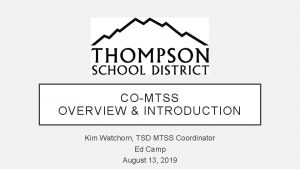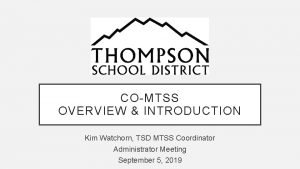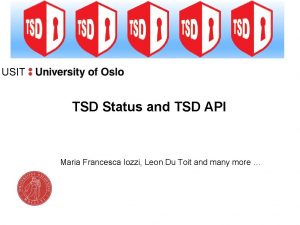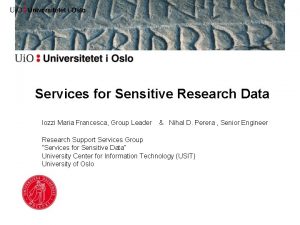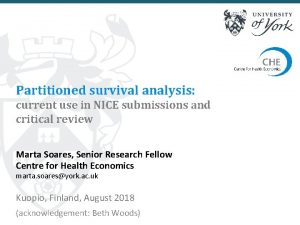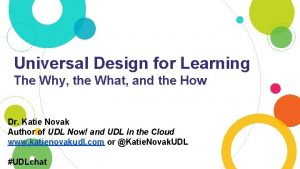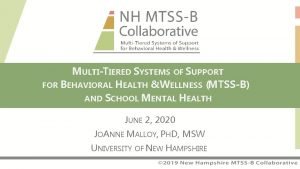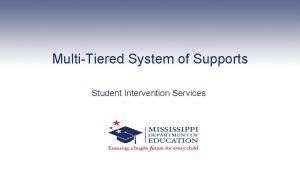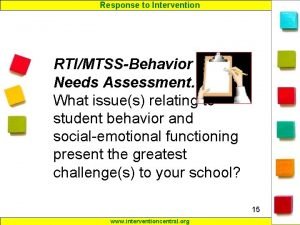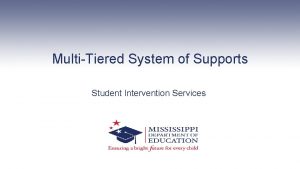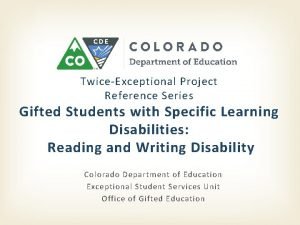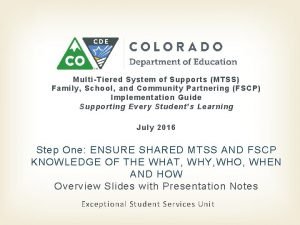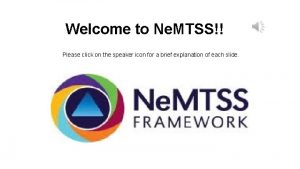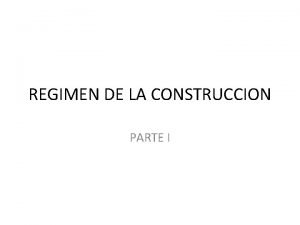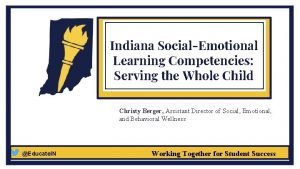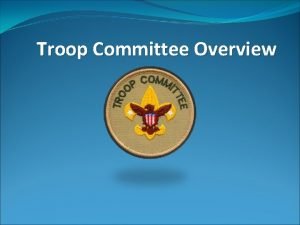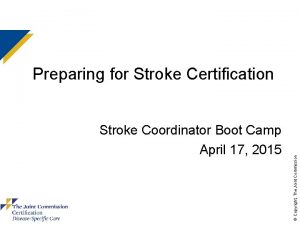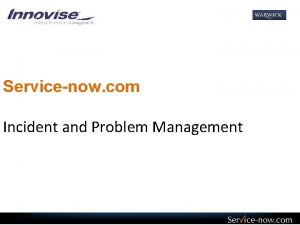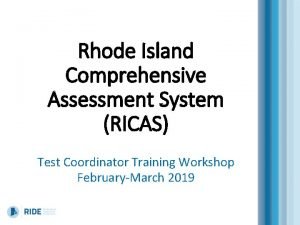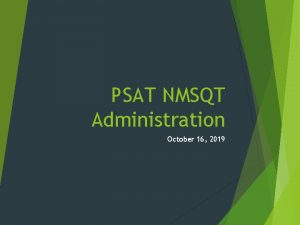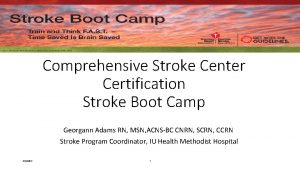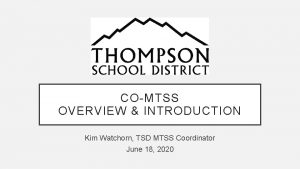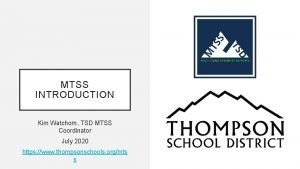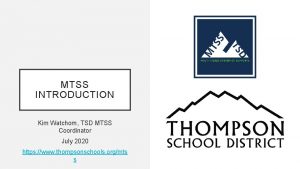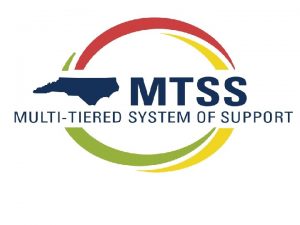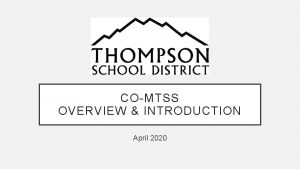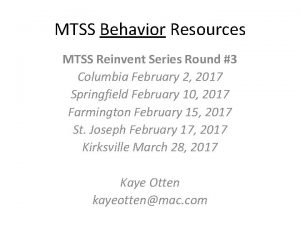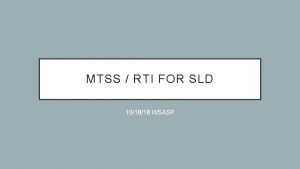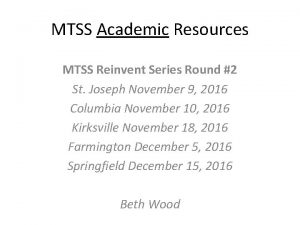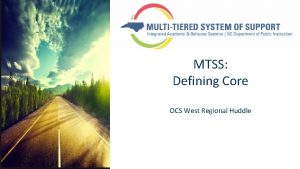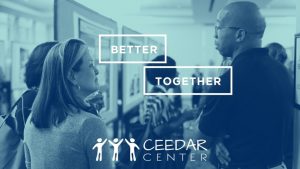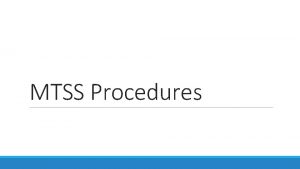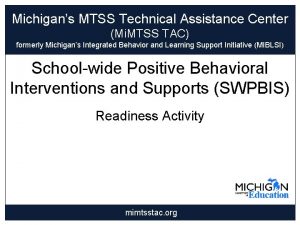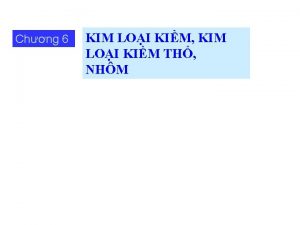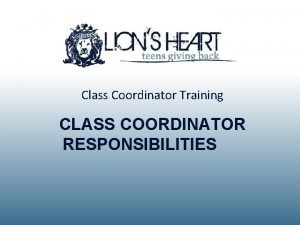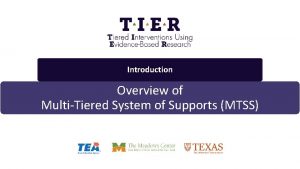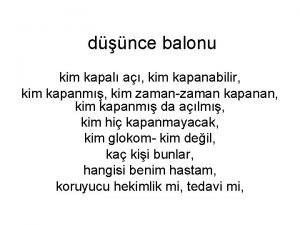COMTSS OVERVIEW INTRODUCTION Kim Watchorn TSD MTSS Coordinator




























- Slides: 28

CO-MTSS OVERVIEW & INTRODUCTION Kim Watchorn, TSD MTSS Coordinator Ed Camp August 13, 2019

This guidance document is meant for clarification, is not legally binding, and is not to be confused with legal advice. This guidance is adapted from CDE’s recommendations, but Local Education Agencies (LEAs) and Administrative Units (AUs) in Colorado may develop their own policies or procedures that differ from those described herein. Be sure to refer to your local policies and procedures through local leadership (e. g. , Directors of Special Education, Title I Coordinators, superintendents) if you are seeking legal advice, please contact your legal counsel. Note that the contents of this presentation and corresponding handouts were developed under a grant from the U. S. Department of Education. However, the content does not necessarily represent the policy of the U. S. Department of Education, and you should not Note: The majority of the content contained in this presentation was originally-created by staff from the Colorado Department of Education (CDE) Office of Learning Supports (OLS).

WHO WE ARE & WHY WE’RE HERE… Session Objectives: Session Facilitator: • Discuss misconceptions Ø Kim Watchorn, TSD MTSS Coordinator • Introduce & examine tools/resources • Consider applications • Possible next steps • Session Participants?

COMMON AGREEMENTS Meeting Norms: 1. Assume Positive Intent 2. Keeping eyes on Common Goal 3. Contribute actively form your own perspective, while holding to the broader view 4. Stay on topic/task 5. Start and end on time 6. Limit side conversations to relevant topics 7. Set a purpose 8. Identify roles and responsibilities 9. Be an active listener 10. Support and Champion the group decision

MAKING PREDICTIONS ? PROMPT(s)… § How would you define MTSS? § What key terms would you expect to be included in a definition of MTSS? § What are “essentials”? 1 min

MTSS FRAMEWORK & ESSENTIAL COMPONENTS Team-Driven Shared Leadership Family, School, and Community Partnering Evidence-Based Practices CDE, 2016 Data-Based Problem Solving and Decision-Making Layered Continuum of Supports

MTSS MAKES IT POSSIBLE IEP AL P CAS SR FSC P UI P REA D ICA P SE BIP L

COMMON LANGUAGE AND COMMON UNDERSTANDING Language reveals belief; belief informs action; action is visible in the behavior of adults …which is what we are trying to change or shape to support students.

WHY MTSS? A Multi-Tiered System of Supports (MTSS) framework helps schools and districts organize resources and align systems. Effective MTSS implementation results in highquality learning environments where all stakeholders feel confident and are competent to successfully engage in school, work, and life.

DEFINITION: MULTI-TIERED SYSTEM OF SUPPORTS IN CO CO-MTSS is a prevention-based framework of team-driven data-based problem solving for improving the outcomes of every student through family, school, and community partnering and a layered continuum of evidence-based practices applied at the classroom, school, district, region, and state level.

MTSS = ORGANIZATIONAL FRAMEWORK • General Education + Special Education [it really is “every ed”…] • Academic + Behavioral Supports • Response to Intervention (Rt. I) + Positive Behavioral Interventions and Supports (PBIS) Note: “Integrated elements” Content adapted from: PBIS TA center • School-wide Systems + Individual Systems • Multiple Funding Streams • Merging Data, Practices, and Systems

DEFINITIONS & CONSIDERATIONS ? PROMPT(s)… § Review the Definitions Handout § Consider key features § How are these component definitions represented in your system? 1 min

One System… (with sub-systems & supports)

FOCUS ON THE SYSTEM To get to “all”, we must pay attention to “every”. We must pay attention to the “system” first, and then, we move to small groups and individuals. -Dave Tilly

School Systems: Classroom Systems: • Homework, grading, make- • up/missed work policies; • Learning structures/strategies • • Teams (e. g. , BLT, PBIS, SAC, PLCs); for engagement; • Homework, grading, make- Transitions/Rotations/Centers • Observation protocols; ; • School-Wide Expectations (e. g. , AVID, behavioral); Acknowledgements/ Celebrations; • Time allocation (for prep & for collaboration); • Peer Coaching/Mentoring; • Data collections • Coaching & PD Delivery; • Unit/Lesson Planning; • Acknowledgements/Celebrations; Personalized Learning Plans • Data collections & analysis • Planning (e. g. , UIP, events, • Scheduling/Management District Systems: Leadership Teams (e. g. , DLT, MLT, DAC); Policies; assessments) Resource Allocation(s); Curriculum Adoption(s); Scheduling/Calendaring; • Delivery; Scheduling/Assignments Acknowledgements/Celebrations; Coaching & PD Planning (e. g. ,

ADDITIONAL INSIGHTS “If you expect it, pre-correct-it. ” (Anita Archer) Attendance Works: https: //www. attendanceworks. org/ Engagement: Early Warning Systems: • Affective • Attendance • Behavioral • Behavior • Cognitive • Class Performance/Course Grade

http: //www. healingtoolbox. org/hol-psy-blog/551 -managing-complex-change-infographic-for-successfulchange-making

CAPACITY BUILDING Letting it happen Recipients are accountable Helping it happen Recipients are accountable Making it happen Purposeful use of implementation practices and science Implementation teams are accountable Based on Greenhalgh, Robert, Mac. Farlane, Bate, & Kyriakidou, 2004

HOW TO ACCELERATE CHANGE

SEEKING BALANCE rtey iuli cbt rtua ustn roa cfc AIn CONDITIONS, t OPERATIONS, r e o r p u PROCEDURESulpt u S C

A SHIFT IN THINKING What about the student STOP is causing a problem? Instead This shift alters everything else! Adapted from Batsche and Elliott materials (citing Ken Howell) What about the interaction of the curriculum, instruction, learners, and learning environment should be altered so that the student(s) will learn?

WHAT DO WE NEED? • A clear model with steps for problem solving routine • Access to the right information at the right time in the right format • A formal/predictable process that a group of people can use to build and implement solutions Newton, J. S. , Todd, A. W. , Algozzine, K. , Horner, R. H. , & Algozzine, B. Version 2 (2012). The Team Initiated Problem Solving (TIPS) Training Manual. Educational and Community Supports, University of Oregon, unpublished training manual.

Reflect on your culture…is it a problem-solving culture? Step 1: Problem Identification DEFINE: What is the problem? Step 4: Plan Evaluation EVALUATE : Did it work? … O ER Z P E T S G IN M A E )T (a D ) (b A T A Step 3: Plan Implementation Step 2: Problem Analysis ANALYZE: Why is it occurring? IMPLEMENT: What can we do about it? Where (within the process) do you dedicate your time? For whom is this process applied? Fluency/Ease of use? Errors/Difficulties?

RESPONSES TO DATA: WHAT IS THE IMPACT? (CONSIDER FIDELITY & OUTCOMES) • Done without fidelity and no growth: restart/enter with implementation as it was planned; consider barriers to implementing [Ask: How can we reduce, eliminate, navigate barriers? ] • Done without fidelity and growth: change the plan/document to reflect “what is done and working” = assess variables; “what variations are occurring that are resulting in gains” • Done with fidelity and no/low growth: re-enter problem solving &/or change intervention (consider changes in intensity level) • Done with fidelity and growth: continue support and/or plan to “fade” or “graduate” (celebrate progress/exit)

LAYERED CONTINUUM: SUPPORT MATCHED TO STAKEHOLDERS’ NEEDS Few = Universal + Targeted + Intensive Some = Universal ALSO Targeted Every = Universal (Note: Visual Representation Adapted from practitioners)

Example: Continuum of Support for one student Math Intensive Targeted Science Writing Spanish Comprehension Decoding Social Skills Universal Social Studies Adapted from George Sugai presentations (2007 -2019) Technology Basketball Label the behavior Dec 7, 2007 or performance or the supports…NOT the individual.

WHEN CLARIFYING NEXT STEPS…CONSIDER…

Kim Watchorn: TSD MTSS Coordinator Email: kim. Watchorn@thompsonschools. org Website: https: //www. thompsonschools. org/mtss Office Phone: 970 -613 -6833
 Comtss
Comtss Comtss
Comtss Usit interface
Usit interface Tsd export files
Tsd export files Partitioned survival model
Partitioned survival model Mtss and udl
Mtss and udl Mtss indiana
Mtss indiana Mtss-b
Mtss-b Mde mtss documentation packet
Mde mtss documentation packet Mtss needs assessment
Mtss needs assessment Mtss documentation packet
Mtss documentation packet Benefits of mtss
Benefits of mtss Mtss
Mtss Mtss nebraska
Mtss nebraska Trazabilidad mtss
Trazabilidad mtss Mtss infographic
Mtss infographic Social emotional learning standards indiana
Social emotional learning standards indiana What is bioinformatics an introduction and overview
What is bioinformatics an introduction and overview Introduction product overview
Introduction product overview Introduction product overview
Introduction product overview Introduction product overview
Introduction product overview Introduction product overview
Introduction product overview Duties and responsibilities of boy scout coordinator
Duties and responsibilities of boy scout coordinator Stroke coordinator boot camp
Stroke coordinator boot camp Service now problem management
Service now problem management Rhode island comprehensive assessment system
Rhode island comprehensive assessment system Psat coordinator manual
Psat coordinator manual Shep coordinator
Shep coordinator Stroke coordinator boot camp
Stroke coordinator boot camp
